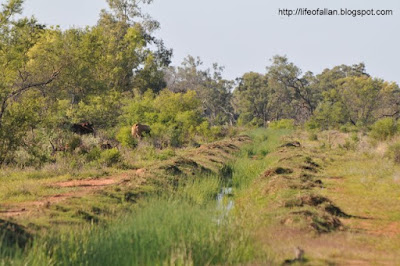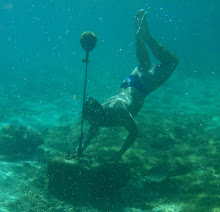
Finally I am ready to start posting some of the photos and stories from my Bowra Station trip. This first prologue will deal with the hardship I had to endure making my way to the south western end of Queensland. Being alone in the car, I took very few photos during the trip, instead I will spice up the story with a few of the photos I managed to take after arriving at Bowra Station late evening after a long day behind the wheel.

My trip had a very chaotic beginning, but thanks to some fantastic people at Bowra and the quality of the place itself, it ended up being some of the best days I have spent in Australia – Bowra is a wildlife and photography heaven.

Australian Green Tree Frog
Litoria caeruleaMy initial plan was to leave Sydney Thursday night after work, make it to Capertee Valley and sleep there, allowing for an early Friday morning start heading up towards Bourke, where I planned to use Friday evening and a bit of Saturday morning in Gundabooka National Park before pushing into Queensland for the main attraction of the trip: Bowra Station.

Some type of Emperor Moth(?),
Saturniidae.
I got to Capertee and had a great sleep, but Friday morning before leaving, I wanted a quick photo of the campsite and realized that my camera battery had been drained from being stored upside down in my backpack – My guess is that trying to squeeze as much camera gear into the pack as possible I had placed the camera so that one of the buttons on the back, probably the live-view button, had been continuously activated causing severe battery drain. What to do? I could take a chance and drive further outback and hope to buy a (charged?) battery in a camera store on the way or, since I had managed to get road ready at an impressive 5.15am, I could drive straight back to work, do a full day in the laboratory, head home, charge the battery, pack the charger(!) and start the drive west again early Saturday morning. I choose the latter. Luckily work was very understanding and I could move my day off from Friday to Tuesday, the entire shenanigans only costing me a drive to Capertee Valley and a bit of packing pride :-)

Tiger Moth,
Arctiidae, Amata sp.
One of the reasons for including Gundabooka National Park on the agenda was that the place had received a good lot of rain recently, which had brought along the chance of seeing a rare and spectacular display of outback wildflowers, plus the wildlife that comes along. Once again my plans were not to be! I had a great early escape from Sydney Saturday morning and was covering good ground. Next to no traffic and the Magna was firing on all cylinders, I got to Nyngan and had still plenty of photography related podcasts to listen to – great drive! As I approached Cobar I realized that I was in trouble – the skies were dark and the land was wetter than I have ever seen the outback. My fears were confirmed at the petrol station in Cobar, the weather forecast predicted lots of rain over the next few days and the police had put out a warning urging people to stay on the bitumen and avoid dirt roads. I decided to drive north towards Bourke – I would be passing the Gundabooka National Park entrance and could take a look and see how bad it looked. As I left Cobar the rain started bucketing down.

I did not even consider driving into Gundabooka! Between Cobar and Bourke I was literally driving through the rain on a piece of tarmac just slightly raised above the two rivers flowing in the trenches next to the road. There was no way I was taking the Magna off-road! Last time I had been in Gundabooka it had been one of the driest places I have ever visited, this time it was turning into an ocean in front of my eyes.
[Notice that the events I am writing about took place in early October, the rains I am talking about have nothing to do with the present flooding in Queensland.]
Where to sleep? I decided to use a bit of logic! :-) Bowra Station is famous for being incredibly dry – it (nearly) never rains and life is only sustained because of spring water on the property, hence creating the unique habitat attracting the rare wildlife I wanted to see. Here I was ca. 400km south nearly drowning in rain .. I decided to continue north!

Finally I had a bit of luck! As I made my way further north the rain became patchy and after entering Queensland I even had glimpses of a setting sun. Arriving at Cunnamulla it was quickly getting dark, those outback towns look significantly more welcoming during the daytime and after that many kilometers behind the wheel it seemed natural to give the last 16km of dirt road a go. I had an excellent description of the way in and I promised myself to turn around if the road was too wet.

It had hardly rained at Bowra and after 20 min on a dirt road as good as some of the bitumen the Magna had been negotiating earlier during the day I was finally there. After nearly 13 hours of solitude in the Magna I was taken aback by the warmest most fantastic welcome I have even been given during any of my endeavors. Before I knew what was happening, the Bowra Station caretakers had managed to sort me a full plate of dinner, a glass of wine and some fantastic company :-)

As mentioned above, I managed to squeeze in 30 min of photography before going to sleep. I was absolutely hammered, but the sounds of a trillion frogs outside the homestead was simply too tempting and I went for a little walk with the Sigma 150mm macro attached, all of the pictures in this blog post are from that first night at Bowra.





























































